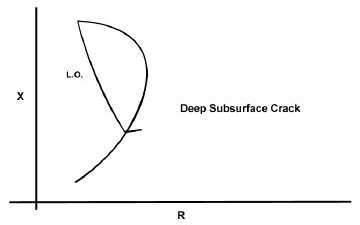T.O. 33B-1-1
4-32
4.3.4.2.4
This same effect continues as the crack is submerged deeper under the surface. The more subsurface the crack goes the
less of the eddy current flow is interrupted, which decreases the amplitude of the crack response. And the farther away
from a surface effect the signal amplitude gets smaller and the phase angle rotates clockwise, away from lift-off (see
Figure 4-29).
Figure 4-29. Deep Subsurface Crack
4.3.4.2.5
Another explanation for this phase angle shift is that changes in the eddy current field take time to travel any distance.
Changes at the surface of the part are seen immediately by the coil, while disturbances to the field at some depth in the
part require some travel time to return to the surface where they are seen by the coil. Electrically, this is described as
phase lag at depth, and the amount of phase lag is 1 radian (57O) per standard depth of penetration (see Figure 4-30).
Figure 4-30. Depth in Part
This phase lag from the lift-off (surface) signal may be used to measure the depth of defects, and this effect is put to
good use in tube testing. The phase angle of a defect signal correlates to defect depth.




